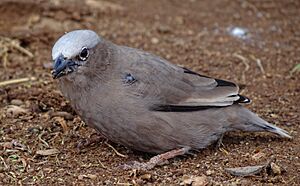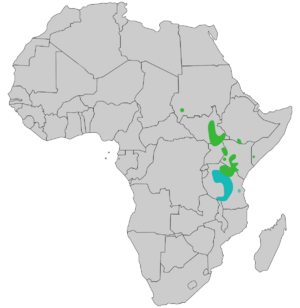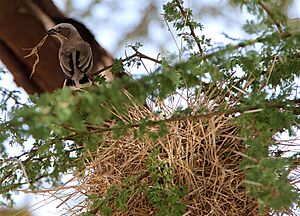Grey-capped social weaver facts for kids
Quick facts for kids Grey-capped social weaver |
|
|---|---|
 |
|
| In Amboseli, Kenya | |
| Conservation status | |
| Scientific classification | |
 |
|
| Synonyms | |
|
The grey-capped social weaver (Pseudonigrita arnaudi) is a small, sparrow-like bird. It has a brownish body, a light grey head, and a dark beak. You can spot a white ring around its eyes. These birds build special nests with roofs and live in groups called colonies. They often choose thorny Acacia trees for their homes.
Grey-capped social weavers eat mostly grass seeds and insects. Both male and female birds look very similar. Scientists have studied their DNA and confirmed they belong to the weaver bird family. You can find these birds in parts of Africa like Ethiopia, Kenya, Somalia, South Sudan, Sudan, Tanzania, and Uganda.
Contents
Discovering the Grey-Capped Social Weaver
The grey-capped social weaver was first described in 1850 by a French scientist named Charles Lucien Bonaparte. He named it Nigrita arnaudi. The name arnaudi was chosen to honor Joseph Pons d'Arnaud. He was a French explorer who found one of these birds around 1841 near Juba. He then sent it to the French Museum of Natural History.
Later, in 1903, a German zoologist named Anton Reichenow gave the bird its current scientific name, Pseudonigrita arnaudi. He created a new group, or genus, called Pseudonigrita. This was because he realized that P. arnaudi and a similar bird, P. cabanisi, were more closely related to weaverbirds. Other birds that were once in the Nigrita group are actually a different type of finch.
The official name for this bird today is the "grey-capped social weaver." This name is used by the International Ornithological Committee. You might also hear it called the grey-headed social weaver or the Masai grey-headed social weaver.
Where They Live: Subspecies and Distribution
There are two main types, or subspecies, of the grey-capped social weaver. The subspecies found further south, called dorsalis, looks a bit different. It has a bluish-grey back instead of a brownish one.
- P. arnaudi arnaudi: This subspecies lives in eastern South Sudan and northern Uganda. It's also found around Mount Elgon and in the central highlands of Kenya. Its range extends south into Tanzania, between Speke Gulf and Mount Kilimanjaro. You can also find smaller groups in southwestern Sudan, southern Ethiopia near Mega, and southern Somalia near Xagar District.
- P. arnaudi dorsalis: This subspecies is found in Tanzania. It lives in an area between the southern shore of Lake Victoria and north of Lake Malawi. There's also a separate group just south of Dar es Salaam.
What They Look Like and Sound Like
The grey-capped social weaver is a small bird, about 11 to 12 centimeters (4.3 to 4.7 inches) long. It weighs between 15 and 26 grams (0.5 to 0.9 ounces). It has a brownish body and a pale grey cap on its head. Its beak is dark grey, and its legs are horn-colored. There's some black on its wings and a light band at the end of its tail. You can see this tail band when the bird flies.
Adult male birds have a cap that is almost white. Females have a slightly lighter grey cap. Young birds look a bit duller. Their beaks are brown, and their caps are a light brownish color.
These birds make a distinct sound. They produce a long series of seven to ten high-pitched, sharp squeaks. It sounds like tseeer-tseeer-tseeer-... repeating.
How They Live: Behaviour
Grey-capped social weavers form pairs and live in groups called colonies. Their behavior is quite similar to another bird called the sociable weaver.
Studies in Kenya showed that some of these birds stay in their nests all year round, even when it's not breeding season. Two to five birds might rest together in one nest. The birds usually don't fight with other families nesting in the same Acacia tree. However, they often attack birds from other trees that try to land in their colony tree. When feeding, the birds follow a pecking order, with dominant birds eating first. But birds from the same colony are more welcome than birds from other colonies. Birds within the same group rarely show aggression towards each other.
What They Eat: Feeding Habits
The grey-capped social weaver eats both grass seeds and insects. Their insect diet includes grasshoppers, beetles, termites, and caterpillars. They usually feed in groups, often a little distance away from their colony.
Raising Young: Reproduction
Grey-capped social weavers breed in colonies. Their nests are used for raising chicks and also for adult birds to sleep in at night. They can breed throughout the year. However, there's a peak breeding time when food is plentiful. For example, this is between August and December in South Sudan, and between March and May in eastern Africa.
Nests hang from thin branches, often in Vachellia drepanolobium trees. Sometimes they use other acacia species like the umbrella thorn acacia (Vachellia tortilis), blackthorn (Senegalia mellifera), or gum acacia (Senegalia senegal). Their nests have roofs and thick walls. They are built from grass straws and can last for many months in dry climates. Birds often build new nests next to or below old ones.
A nest usually has two entrances. One entrance is closed just before the eggs are laid and then opened again when the young birds are ready to leave the nest. A female typically lays four eggs. The eggs are about 19 mm (0.75 inches) long and 14 mm (0.55 inches) wide. They can be greenish, bluish, or white. Some eggs have fine black or olive spots, often more at the wider end. Sometimes, the spots are so dense that the egg looks olive-brown or ash-grey.
Both parents take turns sitting on the eggs, but the female spends about twice as much time incubating. The eggs hatch after about thirteen or fourteen days. When the chicks are very young, they are fed only insects. Grass seeds are added to their diet only during their last few days in the nest. The young birds leave the nest after about twenty days. Older birds from previous broods, both adults and adolescents, often help build nests and feed the new chicks.
The way these birds build their nests helps protect them. Having roofed nests with two downward-facing entrances, nesting in colonies, and choosing thorny trees all help keep predators away. Building nests with thick walls and sleeping together in groups also helps them stay warm during cold nights in their dry habitats.
Sometimes, Chestnut sparrows (Passer eminibey) will take over the nests of grey-capped social weavers. However, Cut-throat finches (Amadina fasciata) only use nests that have already been left empty.
Gallery







